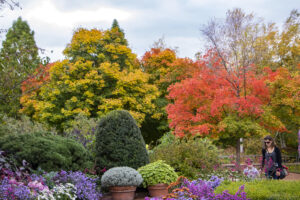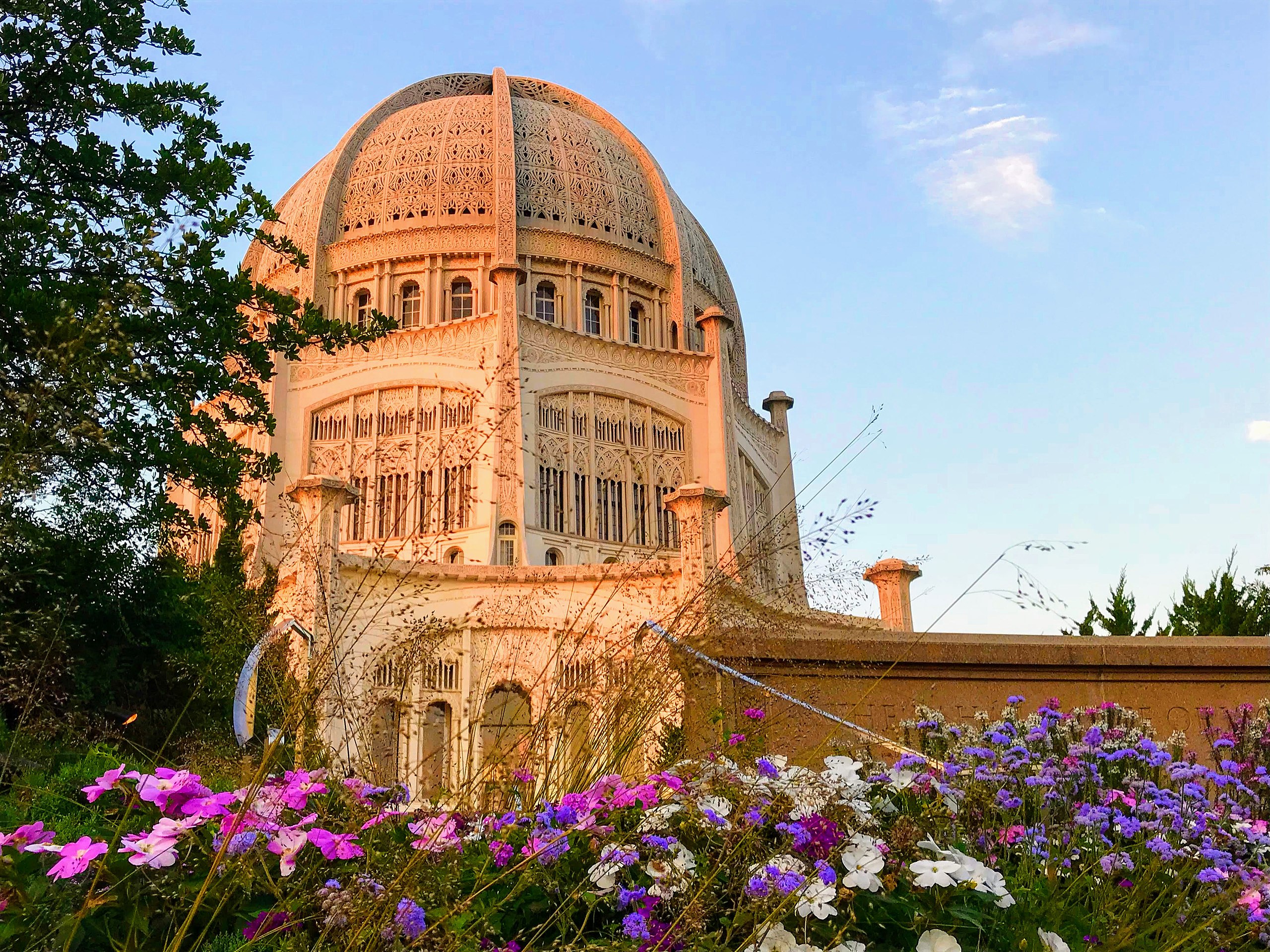When the lake breeze turns crisp and shadows lengthen, autumn on Chicago’s North Shore becomes a master class in light, material, and proportion—best of all, it’s right outside your door — especially if you’re an Optima Verdana® resident. Use this Wilmette-centric guide to plan close-to-home mini adventures that feed your design eye and make the most of golden hour.
Lakefront icons up close
Start with a timeless pairing: the Bahá’í House of Worship and nearby Gillson Park. The Temple’s nine-sided plan, lace-like ornament, and reflecting pools reward slow looking. Arrive just after sunrise or a bit before sunset; low angle light pulls crisp relief from the façade and softens the surrounding gardens. Frame wide to celebrate symmetry, then go tight on repeating motifs for pattern studies.
Walk (or bike) to Gillson for a material contrast—granular sand, limestone revetments, weathered wood, dune grass. Photograph edges: water meeting stone, shadow crossing boardwalk, footprints fading in a breeze. Pro tip: switch your phone to “pro” mode (or lock exposure) and under-expose by a third stop to keep sky detail; an inexpensive clip-on polarizer cuts glare and deepens lake tone.

North Shore Modernism in fall light: a self-guided look from Prairie to Mid-Century
The North Shore is a living survey of clean lines and honest materials. Plot a quiet, sidewalk-only loop through Wilmette and neighboring Evanston to study signatures that read beautifully in autumn:
- Prairie lineage: broad eaves, low rooflines, banded windows, and strong horizontal brick courses that echo the flat Midwest horizon.
- Streamlined Mid-Century: flat or low-pitch roofs, clerestory and corner windows, vertical cedar, and disciplined detailing—no ornament, just proportion.
- Material truth: brick, stone, wood, and glass doing what they do best; fall light reveals the depth of joints, mortar, and grain.
Etiquette matters: admire from public sidewalks, skip close-ups of private interiors, and let the architecture—not the address—be the subject. Pack a small sketchbook; noting eave thickness or window rhythm sharpens your eye for your own home styling back at Optima Verdana®.
Chicago Botanic Garden: balcony design lessons from world-class landscapes
A short drive or bike ride delivers big ideas you can scale to a terrace. As you wander, translate garden moves into balcony rules of thumb:
- Repetition as rhythm: repeat one plant or pot three times for calm; it reads like a chorus line.
- Edit for structure: one evergreen “anchor” (boxwood cone, dwarf pine) + one textural foil (fine grass) + one seasonal accent = a composition that holds through winter.
- Texture over color: in cooler months, contrast leaf shape, blade width, and seedhead silhouette; color is the bonus, not the driver.
- Frame a view: position a taller planter to edge a sightline; negative space is part of the design.
Quick recipes for a North Shore fall container:
- Dwarf conifer + blue fescue + trailing ivy (evergreen backbone with movement)
- Boxwood ball + heuchera (bronze) + ornamental kale (winter-hardy color)
- Switchgrass (compact) + winter pansies + birch branches (height, bloom, sculptural line)
Use fast-draining soil, elevate pots on risers, and topdress with pea gravel or black lava for a clean, modern finish.
Public art, small towns: a walkable Wilmette + Evanston sculpture stroll
Make an afternoon of human-scale civic design. Begin near downtown Wilmette and work your way south by Metra or bike to Evanston. Seek out village-green pieces, library-adjacent works, and storefront installations—fall’s angled light throws generous shadows and makes sculpture pop against brick and limestone. In Evanston, loop through Fountain Square, then toward the Northwestern University campus greens and Lake Michigan for larger outdoor works that borrow the lake and sky as backdrops.
Treat public art as wayfinding: each piece becomes a node on your map, connecting pocket parks, storefronts, and cafés. Pause to note plinth vs. at-grade installations, how materials weather, and how pieces invite (or deny) touch and seating. Grab a warm drink and end at the shoreline for a last look at form against the horizon.
Pack light, look long
- Layer up, bring a small cloth for lens/glasses, and charge your phone.
- For photos: think edge, pattern, proportion; shoot wide, then isolate detail.
- Back home, translate what you saw: edit surfaces, group objects in threes, and let light do more of the work.
In sweater weather, Wilmette becomes your studio: icons, Modernist lines, living landscapes, and civic sculpture—each a short, inspiring journey from your front door.

